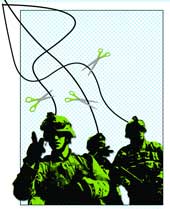Cutting the cords

Wireless bridge makes it a snap to deploy computer networks under harsh conditions.
For the modern Army, setting up a local computer network in a forward area is just as important as pitching tents and hauling in supplies. With that in mind, Defense Department Interoperability Communications Exercises (DICE) are conducted to certify systems for joint interoperability.Starting in 2008, the Joint Interoperability Test Command will hold the exercises three times a year to accommodate the growing need for joint interoperability certifications, assessments and training.At a recent exercise, Fortress Technologies Inc. of Oldsmar, Fla., demonstrated its wireless access bridge, which can be used to quickly establish a computer network in the field. The ES520 is designed as an integrated platform that delivers high-assurance secure wireless communication in deployable environments, said Janet Kumpu, Fortress' president and chief executive officer."We're really targeting applications and solutions that sit at the edge of a network," she said. "This can extend the reach of a network, whether out to an individual soldier or a first responder."The technology combines the functions of access points, wireless bridges, switches and security gateways. In a remote location, the bridge can quickly create a network capable of supporting applications such as voice over IP.The ES520 has a 32-mile point-to-point range and weighs about 3.5 pounds. It has eight local-area network ports, one wide-area network port, a serial console port and two USB ports. Two radios provide the wireless capability ? an 802.11a radio for backhaul and an 802.11a/b/g radio for Wi-Fi access."The whole goal of our solution was to bring those integrated capabilities through a platform that was designed for outdoor use," Kumpu said. The product works in rugged environments and harsh conditions such as desert heat or severe storms, she said.Once the remote network is established, any application ? including video, voice or data ? can run over it.In the DICE test, Fortress partnered with Nortel Government Solutions of Fairfax, Va., and Kestrel Technologies Inc. of New York to integrate VOIP and video into the ad hoc network. Fortress used Kestrel's video surveillance system to deliver high-resolution video via the network. Nortel provided the VOIP capability.The situational awareness demonstration was built around a hypothetical checkpoint monitored by a Kestrel video system.Users monitored the video on laptop and handheld PCs connected to the wireless network. Those devices also had software phones provided by Nortel that enabled them to use the VOIP function, said Richard Gorman, a mobility architect at Nortel Government Solutions."They could see the video input from that camera, and at the same time they had the soft phone capability running on their laptops," Gorman said. "If a situation arose, they could use the VOIP to call up a guard to go to a certain location where the camera spotted something."Nortel's VOIP system can be rackmounted, and the unit is about half again as tall as a server."What's attractive about voice over IP in this situation is that it basically provides anywhere, anytime voice capability just riding over your existing backhaul," Gorman said. "You don't have to worry about running separate digital voice circuits; you just go over that IP backhaul that the mesh is providing."Having applications all ride on the same network makes setup and management easier.The turnkey kits include Fortress' bridge along with voice and video components and are designed for use by people who are not IT experts. Depending on the application being used, the systems are configured so that a virtual wireless connection is automatically created when the power is turned on.Fortress' client software must be loaded onto the device used to access the network. Most users do that ahead of time, "so when you turn on your wireless device and start communicating, it automatically associates with that ES520," Kumpu said.At the DICE test, the system's operational capabilities ? range, throughput, performance and reliability ? were tested successfully. Wired VOIP handsets were also directly connected to the ES520 in the exercise.Kumpu said Army units could have ES520-deployable kits that would sit in a tent and provide wireless communications with soldiers using wireless devices, wearable devices or laptops with Fortress' client.They also could use an ES520 in a command and control center to communicate with an ES520 built into a vehicle, Kumpu said. "They could monitor sensor information as to the health and well-being of that vehicle, and one vehicle could talk to another to create a mobile mesh network."Unmanned aerial vehicles and balloons can also use the technology to provide a wireless video extension for surveillance.

Staff writer Doug Beizer can be reached at dbeizer@1105govinfo.com.

Staff writer Doug Beizer can be reached at dbeizer@1105govinfo.com.
NEXT STORY: On the edge